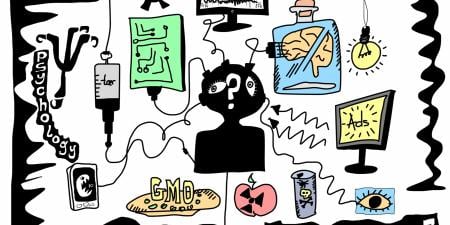Abstract
Approximately 15 percent of women experience depression while pregnant or in the year following pregnancy. While antidepressants are usually effective and considered standard treatment for depression, concerns arise that what might be good for mom could be harmful for the baby. Medical evidence demonstrates that, on balance, treating mental illness with psychotropic medication along with talk therapy is in the best interest of both mother and baby; however, women may resist treatment because they overestimate the risks of medication and underestimate the risks of untreated mental illness. Clinicians can help address this perceived ethical dilemma and provide optimum care to their pregnant patients by collaborating with their patients on a treatment plan, informing them about the risks of untreated mental illness, and providing reassurance that selective serotonin reuptake inhibitors (SSRIs) and many other psychotropic medications are appropriate care even if a woman is pregnant or breastfeeding.
Treatment of depression and other mental illnesses with psychotropic medications during pregnancy can be confusing for both clinicians and pregnant women. The health and well-being of the woman must be considered, but so must that of the fetus. These considerations frequently create an ethical dilemma for a depressed pregnant woman: Should I take psychotropic medication while I’m pregnant?
Perinatal Depression
Perinatal depression occurs during pregnancy and up to 12 months after giving birth [1]. Risk factors include the following:
- A personal or family history of depression, anxiety, or postpartum depression
- Premenstrual dysphoric disorder (PMDD)
- Inadequate support in caring for the baby
- Financial stress
- Marital stress
- Complications in pregnancy, birth, or breastfeeding
- A major recent life event (e.g., loss, including job loss; moving to a new home)
- Being a mother of multiple children
- Being a mother of an infant in a neonatal intensive care unit (NICU)
- Being a mother who has gone through infertility treatments
- Thyroid imbalance
- Diabetes (type 1, type 2, or gestational) [2]
Generally, women of reproductive age experience major depression at twice the rate of men the same age [3, 4]. Major depression is the leading cause of disability for women in this age group [5], and antidepressants are one of the most common drugs prescribed to women of reproductive age [6]. While the myth persists that pregnancy is a time of joyful anticipation, the reality is that pregnancy is not protective for perinatal depression. In fact, 7-20 percent of pregnant women in economically developed countries experience clinical depression [7-9], and being low income, minority, young, or single only increases this risk [10, 11]. Although there are many approaches to treating depression during pregnancy, with varying levels of efficacy, antidepressants have been shown to reduce depressive symptoms and improve maternal function [12].
Should I Take Psychotropic Medication While I’m Pregnant?
Women with a history of depression have already faced the stigma of having a mental illness and might have internalized messages from clinicians, the media, and warning labels on medications that psychotropic medications and pregnancy are incompatible [13-17]. Pregnancy often motivates women to discontinue pharmacotherapy out of concern that the drugs will be harmful to the developing baby [18, 19]. Women without this history of depression, who screen positive for depression during prenatal care, might experience confusion, guilt, and shame over their feelings of sadness or anxiety—especially women facing an unplanned pregnancy—when messages from the social and cultural milieu suggest that pregnancy is a time when they should glow and be happy. These feelings, along with decreased concentration, might impair a woman’s ability to understand and recall information or think through the risks and benefits of treating depression with medication [20]. Indeed, pregnant women routinely overestimate the teratogenic risk of antidepressants [21, 22]. Moreover, women are socialized to believe that good mothers are willing to sacrifice their own well-being for the well-being of their children.
On the other hand, untreated perinatal depression can actually be more harmful than depression experienced at other times in a woman’s life [12, 23, 24]. Women with chronic mental illness who abruptly discontinue pharmacotherapy have a very high risk of relapse during pregnancy [25, 26]. For example, in one study, 68 percent of pregnant women who discontinued antidepressants during pregnancy suffered a relapse of their illness [25], and, in another study, 85 percent of study participants—pregnant women with a history of bipolar disorder who discontinued use of mood stabilizers—experienced a relapse of their illness during pregnancy [26]. Untreated perinatal depression creates additional risks for both mother and baby. Perinatal depression contributes to reduced use of prenatal care, self-neglect, substance abuse, and lower birth weight infants [12, 23, 24]. And suicide causes more maternal deaths than any other pregnancy-related complication [27].
If untreated perinatal depression creates risks for mother and baby, the question remains: Are antidepressants risky for developing fetuses? In light of an observational study that reported adverse neonatal outcomes associated with maternal antidepressant use [28], the US Food and Drug Administration (FDA) released a public health advisory warning in 2006 about the risk of perinatal complications with antidepressants [29]. Although the warning did not explicitly advise women to avoid or discontinue use of antidepressants during pregnancy, it received widespread media coverage [30] and had a chilling effect on antidepressant use among pregnant women [31]. Follow-up studies called into question the findings that led the FDA to issue the warning [12, 24, 32, 33]; in 2011, the FDA announced that since research findings were conflicting, the warning would be removed from selective serotonin reuptake inhibitor (SSRI) labeling [34]. Two decades of experience have demonstrated that SSRIs are not a major teratogen like thalidomide or even cigarette smoking. Reviews of observational studies have argued that observed risks to the fetus may be due to detection bias and confounding factors including maternal depression; in all cases, the absolute risk is very small [23, 35]. Clinicians should keep in mind that the baseline rate of birth defects is 3 percent, with no known cause [36].
Undertreatment of Perinatal Depression
Clinicians also might be confused about how to diagnose and treat maternal mental illness. A 2011 literature review found that though obstetricians and gynecologists view mental health issues as important, they are not confident in their abilities to diagnose these conditions and are concerned about the adequacy of their training [37]. Recent research has found that clinicians might actually be limiting pregnant women’s access to antidepressants by advising them to discontinue medication or even refusing to renew prescriptions once a woman is pregnant [12, 38, 39], and a nationwide survey found that only 12 percent of depressed pregnant women had accessed mental health care in the past 12 months [40].
Providing Care for Pregnant Women with Depression
ACOG guidelines. The American College of Obstetricians and Gynecologists (ACOG) has developed empirically based guidelines for how to diagnose and treat perinatal depression [23]. ACOG recommends that pregnant women with a history of major depressive disorder who are being maintained on an antidepressant should be encouraged to continue medication, and women who choose to discontinue medication ought to taper off and be carefully monitored [23]. Because 1 in 7 pregnant women experience perinatal depression, ACOG further recommends that “clinicians screen patients at least once during the perinatal period for depression and anxiety symptoms … screening must be coupled with appropriate follow-up and treatment when indicated [and] clinical staff … should be prepared to initiate medical therapy, refer patients to appropriate behavioral health resources when indicated, or both” [1]. Additionally, “systems should be in place to ensure follow-up for diagnosis and treatment” [1]. Consistent with these guidelines, researchers have found that simply screening women for depression is not sufficient. Having resources available for women, training for clinicians, onsite assessment, and access to mental health consultation for clinicians treating women in the perinatal period can dramatically improve pregnant women’s access to mental health care [41].
Treatment cessation. Women of reproductive age should be reminded not to discontinue medication abruptly [42], as it can lead to side effects and relapse of symptoms—if they become pregnant. Ideally, women should be advised to schedule an appointment before they become pregnant to work out a treatment plan and coordinate care with whoever will be providing prenatal care.
Screening. Depression screening is now recommended for all pregnant women. The Edinburgh Postnatal Depression Scale is recommended by ACOG for perinatal depression screening and can be completed by the patient in only a few minutes [1]. Depressed women must be further screened for possible bipolar disorder before prescribing an antidepressant because an antidepressant can trigger a manic episode if the woman is actually bipolar [43]. Once bipolar disorder is ruled out, there are guides to help a clinician select appropriate medication, depending on a patient’s level of depression [43].
Treatment decisions. Clinicians need to give as much clinical and ethical consideration to the risks of untreated perinatal depression as they do to the risks of psychotropic medication [44]. The Massachusetts Child Psychiatry Project (MCPAP) for Moms has a discussion guide to help clinicians review the risks and benefits of treatment versus no treatment for depression [43]. To help their patients make decisions, clinicians need to be able to explain differences between relative risk and absolute risk. What sounds like a high relative risk might be clinically insignificant. For example, a study may find that women who take a particular medication during pregnancy are 4 times more likely to have a child with a birth defect than women who do not take the drug; however, this may mean that in a single study there were 4 cases of the birth defect among 4,000 women who took the medication. This translates to an absolute risk of 0.1 percent or one case in 1,000 among women who took the medication compared to 0.025 percent or 1 in 4,000 among women who did not. Finally, women might be comforted to know that millions of women have taken SSRIs during pregnancy and have had healthy babies.
Although shared decision making for treatment of depression is the ideal [45], it is important to realize that women’s decision-making ability can be compromised by their depression and that they could have been misled—perhaps by media—about risks of antidepressants. In this case, directive counseling can be in the patient’s best interest [46]. It builds on a patient’s own values and impulse to do what is in the best interest of her baby. Hearing a clinician say things like, “It’s OK to take your symptoms seriously,” “perinatal depression is extremely common,” and “when you take care of yourself, you are also taking care of your baby,” can validate for a woman that continuing or beginning treatment for depression is a sound decision her clinician supports.
Support Services
Many state and local public health departments as well as academic medical centers and websites are developing resources for perinatal mental health. MCPAP for Moms is a program in Massachusetts that has developed many resources for clinicians to help them manage mental illness in pregnancy. It even has a hotline for clinicians who have specific questions [43]. In a conversation with Nancy Byatt, director of MCPAP for Moms, Byatt said, “this model has been copied by more than 30 states” (personal communication, March 8, 2016). Additionally, academic medical centers are establishing maternal mental health centers that can help not only with the clinical management of specialized cases but also with developing resources and educational programs for community-based clinicians. There are also web-based resources available for clinicians and pregnant and breastfeeding women. At MotherToBaby.org [47], for example, clinicians and concerned women can look up drugs by name and get an up-to-date, evidence-based fact sheet on what is known about the risks of their use during pregnancy and lactation. If a drug is not part of its existing database, MotherToBaby.org provides access to a teratology expert, who is just a phone call away. (Clinicians in Canada might wish to use Motherisk.org [48]).
In addition, a growing number of organizations support the needs of pregnant women, women who have experienced pregnancy loss, and new mothers. Postpartum Support International (PSI) [49] has chapters in most states that provide support groups and, in some cases, hotlines. PSI has a support group through Facebook, special phone applications, and other online media so that women might feel less alone in their struggles to manage their illness and be good mothers. Local health care organizations also sometimes run support groups for women experiencing pregnancy loss and for pregnant or postpartum women struggling with depression.
Conclusion
Because 1 in 7 women will experience depression during the perinatal period [39], clinicians must be prepared to engage in conversations with their patients concerning the management of depression during pregnancy. As discussed, many women with depression can feel conflicted about using medication to treat their depression; therefore, clinicians have obligations to dispel myths about risks of antidepressants and discuss the risks of untreated depression. For women who require treatment for other mental illnesses for which risks and benefits of treatment options are not as established as for depression, longer discussions might be required, along with referrals to perinatal psychiatrists. Fact-based clinical recommendations, good communication that’s responsive to women’s needs, and a shared decision-making model for developing treatment plans can help motivate better clinical and ethical outcomes for both mothers and their babies.
References
-
American College of Obstetricians and Gynecologists. ACOG Committee Opinion 630 Screening for perinatal depression. http://www.acog.org/Resources-And-Publications/Committee-Opinions/Committee-on-Obstetric-Practice/Screening-for-Perinatal-Depression. Published May 2015. Accessed March 18, 2016.
-
Postpartum Support International. Depression During Pregnancy & Postpartum. http://www.postpartum.net/learn-more/depression-during-pregnancy-postpartum/. Accessed April 8, 2016.
- Kessler RC, McGonagle KA, Zhao S, et al. Lifetime and 12-month prevalence of DSM-III-R psychiatric disorders in the United States. Results from the National Comorbidity Survey. Arch Gen Psychiatry. 1994;51(1):8-19.
-
Gaynes BN, Gavin N, Meltzer-Brody S, et al. Perinatal depression: prevalence, screening accuracy, and screening outcomes. Evid Rep Technol Assess. 2005;(119):1-8.
-
World Health Organization. The Global Burden of Disease: 2004 Update. Geneva, Switzerland: World Health Organization; 2008. http://www.who.int/healthinfo/global_burden_disease/GBD_report_2004update_full.pdf. Accessed March 19, 2016.
-
Pratt LA, Brody DJ, Gu Q. Antidepressant use in persons aged 12 and over: United States, 2005-2008. NCHS Data Brief. 2011;(76):1-8. http://www.cdc.gov/nchs/data/databriefs/db76.htm. Published October 2011. Accessed March 18, 2016.
- Evans J, Heron J, Francomb H, Oke S, Golding J. Cohort study of depressed mood during pregnancy and after childbirth. BMJ. 2001;323(7307):257-260.
- Lee AM, Lam SK, Sze Mun Lau SM, Chong CS, Chui HW, Fong DY. Prevalence, course, and risk factors for antenatal anxiety and depression. Obstet Gynecol. 2007;110(5):1102-1112.
- Gavin NI, Gaynes BN, Lohr KN, Meltzer-Brody S, Gartlehner G, Swinson T. Perinatal depression: a systematic review of prevalence and incidence. Obstet Gynecol. 2005;106(5)(pt 1):1071-1083.
- Hobfoll SE, Ritter C, Lavin J, Hulsizer MR, Cameron RP. Depression prevalence and incidence among inner-city pregnant and postpartum women. J Consult Clin Psychol. 1995;63(3):445-453.
- Orr ST, Blazer DG, James SA. Racial disparities in elevated prenatal depressive symptoms among black and white women in eastern North Carolina. Ann Epidemiol. 2006;16(6):463-468.
- Wisner KL, Sit DK, Hanusa BH, et al. Major depression and antidepressant treatment: impact on pregnancy and neonatal outcomes. Am J Psychiatry. 2009;166(5):557-566.
-
Matsui D. Adherence with drug therapy in pregnancy. Obstet Gynecol Int. 2012;2012:796590. http://www.hindawi.com/journals/ogi/2012/796590/. Accessed May 6, 2016.
- Mulder E, Davis A, Gawley L, Bowen A, Einarson A. Negative impact of non-evidence-based information received by women taking antidepressants during pregnancy from health care providers and others. J Obstet Gynaecol Can. 2012;34(1):66-71.
- Nordeng H, Ystrøm E, Einarson A. Perception of risk regarding the use of medications and other exposures during pregnancy. Eur J Clin Pharmacol. 2010;66(2):207-214.
- Koren G. The way women perceive teratogenic risk. Can J Clin Pharmacol. 2007;14(1):e10-e16.
- Bonari L, Koren G, Einarson TR, Jasper JD, Taddio A, Einarson A. Use of antidepressants by pregnant women: evaluation of perception of risk, efficacy of evidence based counseling and determinants of decision making. Arch Womens Ment Health. 2005;8(4):214-220.
- Petersen I, Gilbert RE, Evans SJ, Man SL, Nazareth I. Pregnancy as a major determinant for discontinuation of antidepressants: an analysis of data from The Health Improvement Network. J Clin Psychiatry. 2011;72(7):979-985.
- Bennett IM, Marcus SC, Palmer SC, Coyne JC. Pregnancy-related discontinuation of antidepressants and depression care visits among Medicaid recipients. Psychiatr Serv. 2010;61(4):386-391.
- Battle CL, Salisbury AL, Schofield CA, Ortiz-Hernandez S. Perinatal antidepressant use: understanding women’s preferences and concerns. J Psychiatr Pract. 2013;19(6):443-453.
- Turner KM, Sharp D, Folkes L, Chew-Graham C. Women’s views and experiences of antidepressants as a treatment for postnatal depression: a qualitative study. Fam Pract. 2008;25(6):450-455.
- Bonari L, Pinto N, Ahn E, Einarson A, Steiner M, Koren G. Perinatal risks of untreated depression during pregnancy. Can J Psychiatry. 2004;49(11):726-735.
- Yonkers KA, Wisner KL, Stewart DE, et al. The management of depression during pregnancy: a report from the American Psychiatric Association and the American College of Obstetricians and Gynecologists. Gen Hosp Psychiatry. 2009;31(5):403-413.
- Alder J, Fink N, Bitzer J, Hösli I, Holzgreve W. Depression and anxiety during pregnancy: a risk factor for obstetric, fetal and neonatal outcome? A critical review of the literature. J Matern Fetal Neonatal Med. 2007;20(3):189-209.
- Cohen LS, Altshuler LL, Harlow BL, et al. Relapse of major depression during pregnancy in women who maintain or discontinue antidepressant treatment. JAMA. 2006;295(5):499-507.
- Viguera AC, Whitfield T, Baldessarini RJ, et al. Risk of recurrence in women with bipolar disorder during pregnancy: prospective study of mood stabilizer discontinuation. Am J Psychiatry. 2007;164(12):1817-1824.
- Shadigian E, Bauer ST. Pregnancy-associated death: a qualitative systematic review of homicide and suicide. Obstet Gynecol Surv. 2005;60(3):183-190.
- Chambers CD, Hernandez-Diaz S, Van Marter LJ, et al. Selective serotonin-reuptake inhibitors and risk of persistent pulmonary hypertension of the newborn. New Engl J Med. 2006;354(6):579-587.
-
US Food and Drug Administration. Public health advisory: treatment challenges of depression in pregnancy and the possibility of persistent pulmonary hypertension in newborns. http://www.fda.gov/Drugs/DrugSafety/PostmarketDrugSafetyInformationforPatientsandProviders/ucm124348.htm. Published July 19, 2006. Updated August 16, 2013. Accessed March 18, 2016.
- Einarson A. Influence of the media on women taking antidepressants during pregnancy. J Clin Psychiatry. 2009;70(9):1313-1314.
- Bobo WV, Epstein RA Jr, Hayes RM, et al. The effect of regulatory advisories on maternal antidepressant prescribing, 1995-2007: an interrupted time series study of 228,876 pregnancies. Arch Womens Ment Health. 2014;17(1):17-26.
-
Einarson A. The safety of psychotropic drug use during pregnancy: a review. MedGenMed. 2005;7(4):3. http://www.medscape.org/viewarticle/512650. Accessed May 6, 2016.
- Koren G, Nordeng H. Antidepressant use during pregnancy: the benefit-risk ratio. Am J Obstet Gynecol. 2012;207(3):157-163.
-
US Food and Drug Administration. FDA drug safety communication: selective serotonin reuptake inhibitor (SSRI) antidepressant use during pregnancy and reports of a rare heart and lung condition in newborn babies. http://www.fda.gov/Drugs/DrugSafety/ucm283375.htm. Published December 14, 2011. Updated March 10, 2016. Accessed March 18, 2016.
-
Koren G, Nordeng HM. Selective serotonin reuptake inhibitors and malformations: case closed? Semin Fetal Neonatal Med. 2013;18(1):19-22.
-
Centers for Disease Control and Prevention. Update on overall prevalence of major birth defects—Atlanta, Georgia, 1978-2005. MMWR Morb Mortal Wkly Rep. 2008;57(01):1-5. http://www.cdc.gov/mmwr/preview/mmwrhtml/mm5701a2.htm. Accessed April 14, 2016.
- Leddy MA, Lawrence H, Schulkin J. Obstetrician-gynecologists and women’s mental health: findings of the Collaborative Ambulatory Research Network 2005-2009. Obstet Gynecol Surv. 2011;66(5):316-323.
- Byatt N, Biebel K, Debordes-Jackson G, et al. Community mental health provider reluctance to provide pharmacotherapy may be a barrier to addressing perinatal depression: a preliminary study. Psychiatr Q. 2013;84(2):169-174.
- Weinreb L, Byatt N, Moore Simas TA, Tenner K, Savageau JA. What happens to mental health treatment during pregnancy? Women’s experience with prescribing providers. Psychiatr Q. 2014;85(3):349-355.
- Byatt N, Xiao RS, Dinh KH, Waring ME. Mental health care use in relation to depressive symptoms among pregnant women in the USA. Arch Womens Ment Health. 2016;19(1):187-191.
- Byatt N, Levin LL, Ziedonis D, Moore Simas TA, Allison J. Enhancing participation in depression care in outpatient perinatal care settings: a systematic review. Obstet Gynecol. 2015;126(5):1048-1058.
- Rosenbaum JF, Zajecka J. Clinical management of antidepressant discontinuation. J Clin Psychiatry. 1997;58(suppl 7):37-40.
-
Massachusetts Child Psychiatry Access Project. MCPAP for moms toolkit—adult provider. https://www.mcpapformoms.org/Toolkits/Toolkit.aspx. Accessed March18, 2016.
- Lyerly AD, Mitchell LM, Armstrong EM, et al. Risk and the pregnant body. Hastings Cent Rep. 2009;39(6):34-42.
- Price SK, Bentley KJ. Psychopharmacology decision-making among pregnant and postpartum women and health providers: informing compassionate and collaborative care women’s health. Women Health. 2013;53(2):154-172.
- Coverdale JH, McCullough LB, Chervenak FA, Bayer T, Weeks S. Clinical implications of respect for autonomy in the psychiatric treatment of pregnant patients with depression. Psychiatr Serv. 1997;48(2):209-212.
-
MotherToBaby website. http://mothertobaby.org/. Accessed March 19, 2016.
-
Motherisk website. http://motherisk.org/women/index.jsp. Accessed March 19, 2016.
-
Postpartum Support International website. http://www.postpartum.net/. Accessed March 23, 2016.



